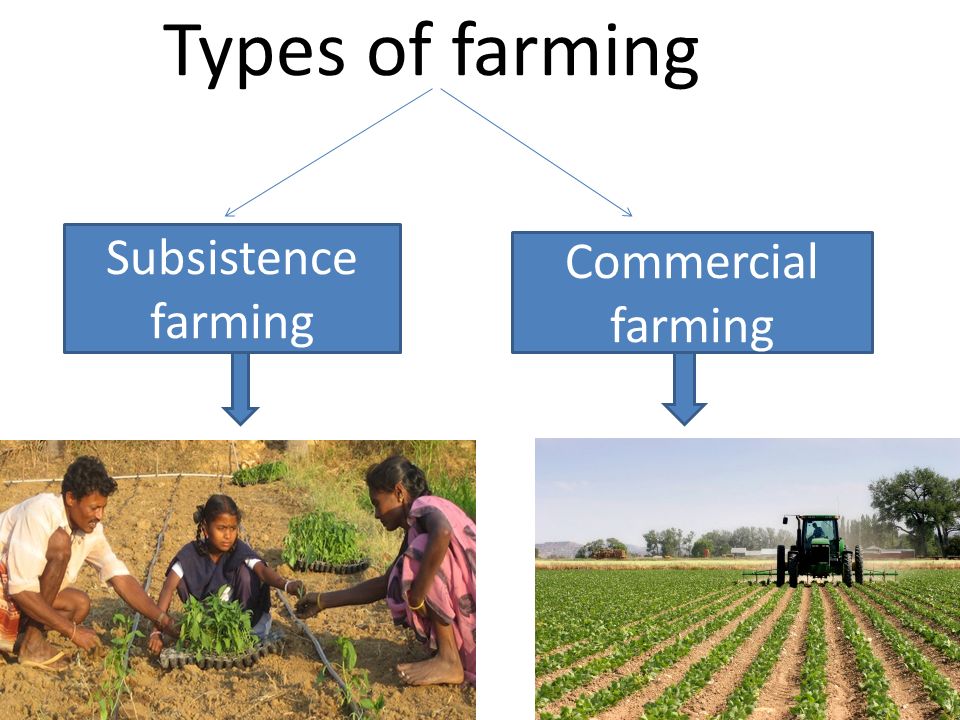Benefits and Difficulties of Commercial Farming vs Subsistence Farming Clarified
Benefits and Difficulties of Commercial Farming vs Subsistence Farming Clarified
Blog Article
Exploring the Distinctions In Between Commercial Farming and Subsistence Farming Practices
The dichotomy between business and subsistence farming methods is noted by differing purposes, operational ranges, and resource application, each with extensive implications for both the environment and culture. Conversely, subsistence farming emphasizes self-sufficiency, leveraging conventional techniques to sustain household demands while nurturing community bonds and cultural heritage.
Economic Objectives
Economic objectives in farming practices commonly determine the methods and scale of operations. In industrial farming, the primary economic objective is to make the most of profit.
On the other hand, subsistence farming is mostly oriented towards fulfilling the prompt demands of the farmer's family members, with surplus production being very little. The economic objective right here is frequently not make money maximization, yet instead self-sufficiency and danger reduction. These farmers commonly operate with restricted resources and depend on typical farming strategies, customized to neighborhood ecological conditions. The main objective is to make sure food protection for the household, with any excess produce offered locally to cover basic requirements. While industrial farming is profit-driven, subsistence farming is centered around sustainability and resilience, mirroring an essentially different collection of economic imperatives.

Range of Workflow
The difference in between industrial and subsistence farming comes to be specifically obvious when taking into consideration the scale of procedures. Industrial farming is defined by its massive nature, usually including extensive tracts of land and utilizing advanced machinery. These procedures are usually incorporated right into international supply chains, creating huge amounts of crops or livestock meant offer for sale in worldwide and domestic markets. The range of business farming permits economic climates of range, leading to minimized costs per unit through mass manufacturing, enhanced effectiveness, and the capacity to purchase technological improvements.
In stark comparison, subsistence farming is typically small-scale, concentrating on producing simply enough food to fulfill the prompt demands of the farmer's family members or local area. The land location involved in subsistence farming is commonly restricted, with less accessibility to contemporary innovation or automation. This smaller range of procedures mirrors a dependence on traditional farming techniques, such as hands-on labor and simple devices, bring about lower productivity. Subsistence ranches focus on sustainability and self-sufficiency over earnings, with any type of surplus typically traded or bartered within neighborhood markets.
Source Use
Source utilization in farming methods discloses significant differences in between business and subsistence strategies. Commercial farming, identified by massive operations, usually utilizes innovative innovations and automation to enhance making use of sources such as land, water, and plant foods. These methods permit enhanced performance and higher productivity. The emphasis is on making the most of results by leveraging economic climates of scale and deploying resources purposefully to guarantee regular supply and profitability. Accuracy farming is increasingly taken on in commercial farming, using information analytics and satellite technology to monitor crop wellness and optimize resource application, more boosting yield and resource performance.
In contrast, subsistence farming runs on a much smaller range, mostly to meet the prompt requirements of the farmer's household. Source usage in subsistence farming is frequently restricted by monetary constraints and a dependence on conventional strategies.
Environmental Influence

Conversely, subsistence farming, exercised on a smaller range, normally utilizes typical strategies that are extra in harmony with the surrounding environment. Plant turning, intercropping, and natural fertilization prevail, advertising dirt health and reducing the need for synthetic inputs. While subsistence farming normally has a reduced ecological footprint, it is not without challenges. Over-cultivation and poor land management can bring about dirt disintegration and logging in many cases.
Social and Cultural Ramifications
Farming methods are deeply intertwined with the social and social material of communities, influencing and mirroring their worths, traditions, and economic frameworks. In subsistence farming, the emphasis is on growing sufficient food to meet the prompt requirements of the farmer's family, often fostering a solid sense of community and my company shared duty. Such methods are deeply rooted in neighborhood customs, with knowledge gave with generations, thereby maintaining cultural heritage and enhancing public connections.
Conversely, business farming is mainly driven by market needs and earnings, frequently causing a shift in the direction of monocultures and massive procedures. This method can bring about the erosion of standard farming practices and social identities, as regional customizeds and expertise are supplanted by standard, industrial techniques. The focus on effectiveness and earnings can sometimes reduce the social communication found in subsistence neighborhoods, as economic purchases replace community-based exchanges.
The dichotomy between these farming techniques highlights the broader social implications of agricultural options. While subsistence farming sustains social continuity and community interdependence, business farming straightens with globalization and financial development, often at the cost of standard social frameworks and multiculturalism. commercial farming vs subsistence farming. Stabilizing these facets stays an important difficulty for sustainable agricultural development
Conclusion
The exam of industrial and subsistence farming practices discloses substantial distinctions in goals, scale, source usage, environmental influence, and social informative post ramifications. Conversely, subsistence farming stresses self-sufficiency, utilizing conventional approaches and regional resources, therefore promoting social preservation and area cohesion.
The duality between commercial and subsistence farming methods is marked by varying objectives, functional ranges, and source use, each with extensive effects for both the setting and culture. While commercial farming is profit-driven, subsistence farming is focused around sustainability and resilience, reflecting a basically different collection of economic imperatives.
The distinction in between commercial and subsistence farming comes to be particularly obvious when considering the scale of procedures. While subsistence farming supports cultural connection and community connection, business farming website here aligns with globalization and financial development, typically at the price of traditional social structures and social variety.The evaluation of industrial and subsistence farming techniques discloses considerable distinctions in purposes, scale, resource use, ecological influence, and social implications.
Report this page